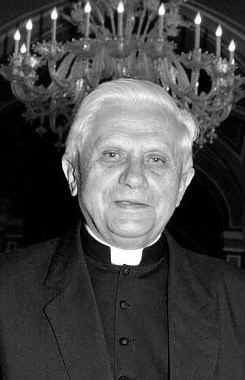 Anthony Grafton, a professor of history at Princeton University, has written a thoughtful summary of Pope Benedict XVI's writings (The New Yorker, July 25). I apologize for my delay in mentioning this essay -- it never appeared on The New Yorker's website, and the paper edition often reaches my home rather late in the publication week.
An illustration by Robert Risko depicts Ratzinger as a Pope Noferatu, clutching an inaccurately thick copy of The Ratzinger Report that's marked with six small Post-It notes. Grafton's profile is less prone to caricature, though he often returns to the image of Ratzinger as a man who prefers the shelter of "an enchanted castle of Latin song and prayer, intense and sacraments, which he has spent the rest of life exploring."
Anthony Grafton, a professor of history at Princeton University, has written a thoughtful summary of Pope Benedict XVI's writings (The New Yorker, July 25). I apologize for my delay in mentioning this essay -- it never appeared on The New Yorker's website, and the paper edition often reaches my home rather late in the publication week.
An illustration by Robert Risko depicts Ratzinger as a Pope Noferatu, clutching an inaccurately thick copy of The Ratzinger Report that's marked with six small Post-It notes. Grafton's profile is less prone to caricature, though he often returns to the image of Ratzinger as a man who prefers the shelter of "an enchanted castle of Latin song and prayer, intense and sacraments, which he has spent the rest of life exploring."
Here is a key paragraph toward the end of Grafton's essay:
In some sense, Ratzinger may be right: the form of our devotions certainly shapes our religious experience. Even in the secularized West, religions and denominations from Catholicism to Reform Judaism have found that a liturgy rich with music and cast in a sacred language continues to attract and hold worshippers. Yet Ratzinger's passion for a particular world of Catholic beliefs and devotions is more than a recipe for a revived Catholic worship. His emotional vision underpins and buttresses at every point the doctrinal structures that he has made as a scholar. In the end, it determines what he can accept as suitable and what he rejects. As the organ and liturgy drown out the weaker voices of liberal critics, as the searchlight of orthodoxy retrospective reveals the errors of Leonardo Boff and other dissidents, the Pope and the magisterium -- the centralized authority of Roman Catholic wisdom -- have no need to look outside for enlightenment.
